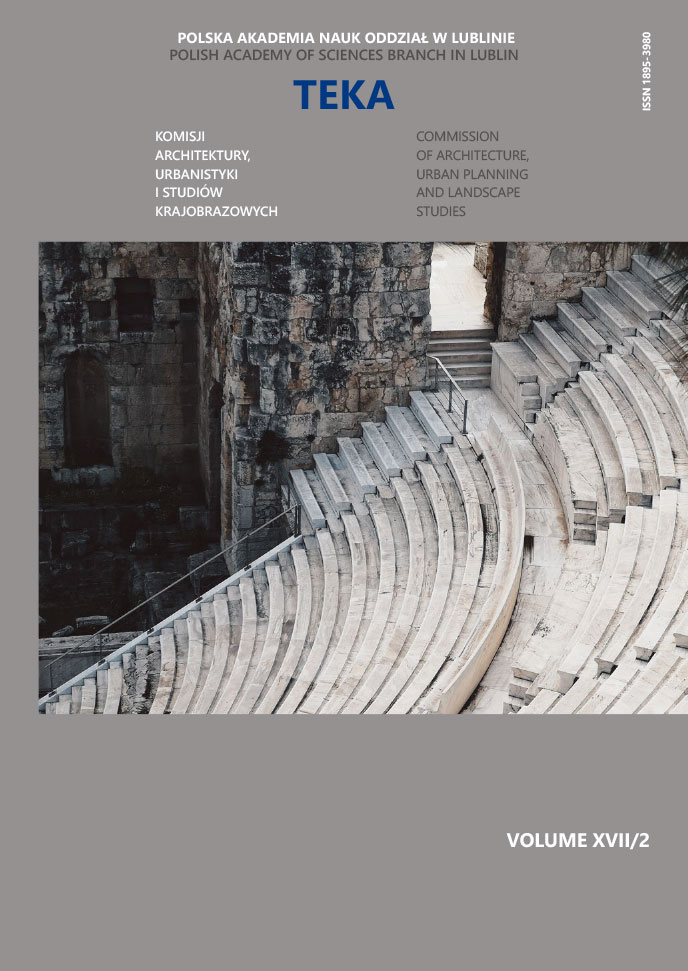The importance of creating a cultural park within the historical center of Zamość. Good practices. The cultural park is not the Zamość Park
Article Sidebar
Open full text
Issue Vol. 17 No. 2 (2021)
-
Retrospection: genesis and durability of post‑war polychromes of tenement houses in the Old Market Square in Poznań
Andrzej Łubowski7-16
-
The importance of creating a cultural park within the historical center of Zamość. Good practices. The cultural park is not the Zamość Park
Katarzyna Kielin17-23
-
Flat pneumatic elements and their potential use in the construction of dwelling facilities within emergency housing systems
Witold Szymański24-36
-
The technology that meets modern human needs – criteria of assessment of smart home system
Dariusz Gaweł37-44
-
Use and functioning of the castle ruins in Iłża
Katarzyna Drobek, Maciej Trochonowicz45-54
-
Criteria of livable public spaces quality. Case study analysis on the example of selected public spaces Lublin, Poland
Agnieszka Chęć-Małyszek55-75
-
Voice in the discussion about the original architecture of the Powder Tower and the 16th century third defensive line in the Lviv Middletown
Mykola Bevz76-86
-
Building engineering issues in Architectural education in Poland, in context of actual Ministry of Science and Higher Education Regulations
Zuzanna Napieralska, Marek Piróg, Natalia Przesmycka, Agata Pięt, Marcin Zdanowicz87-95
Archives
-
Vol. 19 No. 2
2023-12-29 11
-
Vol. 19 No. 1
2023-12-19 13
-
Vol. 18 No. 4
2022-12-30 5
-
Vol. 18 No. 3
2022-12-27 5
-
Vol. 18 No. 2
2022-12-27 5
-
Vol. 18 No. 1
2022-12-27 4
-
Vol. 17 No. 4
2021-12-30 11
-
Vol. 17 No. 3
2021-12-30 9
-
Vol. 17 No. 2
2021-12-30 8
-
Vol. 17 No. 1
2021-12-30 8
-
Vol. 16 No. 4
2020-12-30 11
-
Vol. 16 No. 3
2020-09-30 10
-
Vol. 16 No. 2
2020-06-30 11
-
Vol. 16 No. 1
2020-03-31 10
-
Vol. 15 No. 4
2019-12-30 6
-
Vol. 15 No. 3
2019-10-31 9
-
Vol. 15 No. 2
2019-06-28 12
-
Vol. 15 No. 1
2019-03-29 13
Main Article Content
DOI
Authors
Abstract
Zamość is a town of remarkable urban landscape and architecture. The first urban idea on the masterpiece of Italian-style fortification from the late 16th century evolved gradually throughout centuries until 19th century. The plan and examples of architectural pearls are stylistically homogenous. The fortifications underwent many transformations and 21st century brought some outstanding projects for the reconstruction of substantial amount of fortress elements. The Zamość Park retained the green parts of fortifications which added to its undoubted picturesqueness. The Zamość unique and valuable urban layout and architectural splendor call for creating suitable preservation and clear rules of management. Such tools can be achieved by forming a cultural park – mentioned in the Act on the Protection and Care of Monuments as one of the ways of protection of urban and architectural monuments. The term should not be confused with a notion of a park as an arrangement, composition of greenery on a particular terrain.
Keywords:
References
Przegon W., Gospodarowanie krajobrazem w historycznym centrum Zamościa, Czasopismo Techniczne, Wydawnictwo Politechniki Krakowskiej, z. 7-A/ 2008, ISSN 0011-4561, ISSN 1897-6271, p. 89.
Pudelska K., Rojek K., Zmiany w strukturze drzewostanu w XIX wiecznym Parku w Czesławicach, Teka Kom. Arch. Urb. Stud. Krajobr. – OL PAN, 2013, IX/3, 56−63. DOI: https://doi.org/10.35784/teka.2556
Walerian Kronenberg – Wikipedia, wolna encyklopedia, access: 16.03.2021.
Zamościopedia – PARK MIEJSKI (http://zamosciopedia.pl); access: 16.03.2021.
Kałamucka W., Parki kulturowe w Województwie Lubelskim, Zarządzanie Krajobrazem Kulturowym.
Myczkowski Z., Krajobraz warowny Twierdzy Zamość w kontekście idei tożsamości miejsca i jej składników (Strategic landscape of Zamość fortress in context of idea of identity of place and its parameters), TEKA KOMISJI URBANISTYKI I ARCHITEKTURY PAN ODDZIAŁ W KRAKOWIE TOM XLIII (2015) PL ISSN 0079-3450 s. 113−125, PL eISSN 2450-0038.
Park Kulturowy. Czyli jak zadbać o estetykę Starego Miasta, park kulturowy_broszura (1).pdf.
Old City of Zamość – UNESCO World Heritage Centre; access: 17.03.2021.
Sawa B., Dzieje zamojskiego parku, Zamojski Kwartalnik Kulturalny, 2004 (1−2), p. 89−99, Biblioteka Cyfrowa dLibra – Zamojski Kwartalnik Kulturalny, 2004, Nr 1−2 (78−79) (http://zamosc.pl).
Old City of Zamość – UNESCO World Heritage Centre; access: 17.03.2021.
Szmygin B., Fortuna-Marek A., Siwek A., Gminny program opieki nad zabytkami miasta Zamościa, Strategiczny dokument samorządu w ochronie zabytków, Lublin 2020; *siwek_et-al_gminny_program_opieki_nad_zabytkami_miasta_zamoscia_2020.pdf; access: 19.03.2021.
Szmygin B., Fortuna-Marek A., Siwek A., Stare Miasto w Zamościu. Dobro Światowego Dziedzictwa UNESCO. Ocena wartości i plan zarządzania, Zamość 2018.
Article Details
Abstract views: 196
License

This work is licensed under a Creative Commons Attribution-ShareAlike 4.0 International License.


